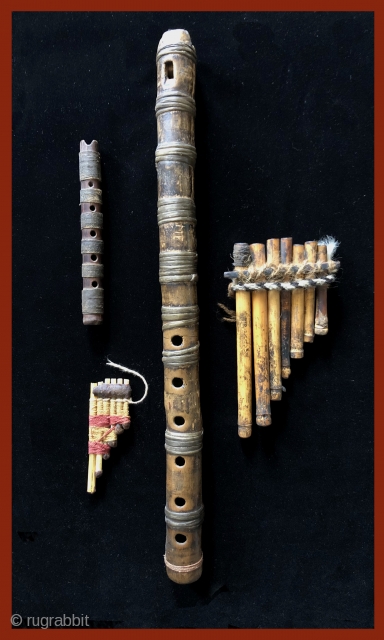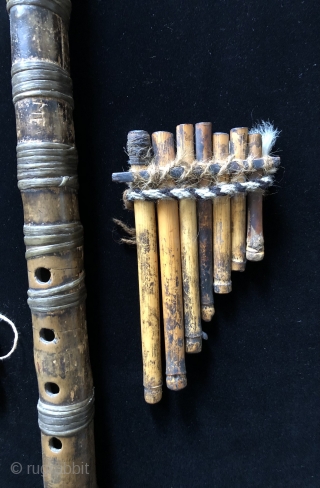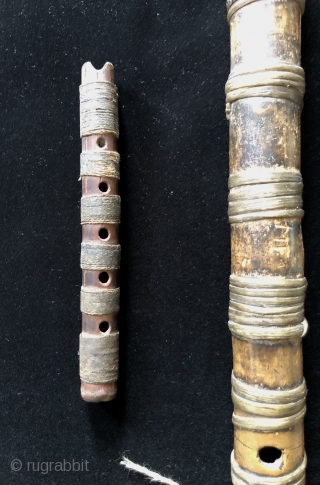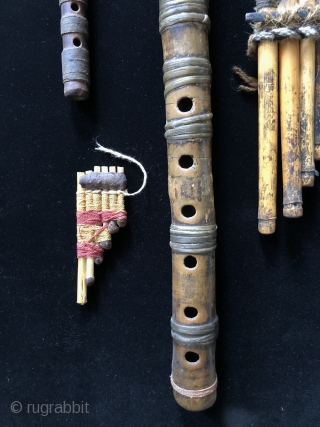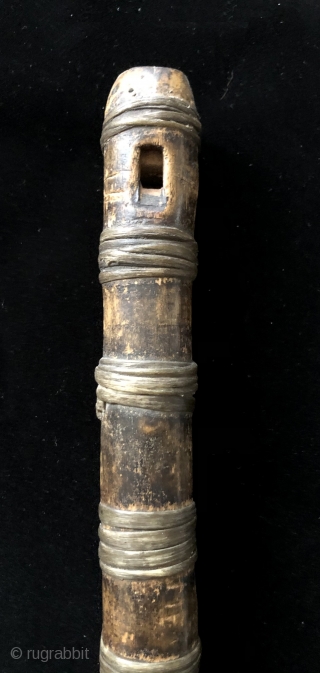Back
Andean Wind Instruments. For millennia Andean people have been playing wind instruments. Music was a vital part of Andean ritual and ceremony. Seen here are two Pre-Columbian panpipes and two flutes from the Andes. The panpipe is a musical instrument composed of end-blown tubes of different lengths tied together. Panpipes seem to be almost universal. They can be traced back to the Neolithic, and have been found at prehistoric sites in China, Europe and South America. Andean panpipes developed independently from the old world panpipes, but are remarkably similar in construction. The smaller of these seen here is made from bird bone wrapped with dyed alpaca and cotton yarns. Pine pitch was used to plug the ends and as a binder near the top of the instrument. This small piece is likely from the Chimu Culture of Peru. a.d. 1000 - 1400. The larger set of pipes is made from seven tubes of river cane bound with llama fiber yarns wrapped around split cane with a braided bit of llama cordage added. It dates from about the same period, but comes from the Lake Titicaca Basin. Both panpipes still play. The smallest of the single tube flutes is an early Nasca end blown flute wrapped with cordage coated in a tar-like substance. The large flute is from the altiplano region of Bolivia and has a block type sound mechanism. It was made by splitting a piece of wood length-wise and gouging out a channel down the centers of each half and then was put back together with multiple wrappings of llama sinew. Both the sinew and the wood have a wonderful patina indicating many years of usage. It is probably from the 19th century or before and still plays.
price:
Inquire
- Home
- Antique Rugs by Region
- Category
- Profiles
- Post Items Free
- Albums
- Benaki Museum of Islamic Art
- Budapest: Ottoman Carpets
- Gulbenkian Museum
- Islamic Carpets. Brooklyn
- Islamic Textiles. Brooklyn
- Konya Museum: Rugs
- MKG, Hamburg
- MMA: Caucasian Carpets
- MMA: Mamluk Carpets
- MMA: Mughal Indian Carpets
- MMA: Ottoman Carpets
- MMA: Safavid Persian Carpets
- MMA: Turkmen Rugs
- McCoy Jones Kilims
- Ottoman textiles. Met
- Philadelphia Museum
- Rugs and Carpets: Berlin
- Seljuqs at the Met
- TIEM, Istanbul: Carpets
- V&A: Classical Carpets
- Vakiflar Carpets: Istanbul
- Baluch Rugs: Indianapolis
- Gallery Exhibitions
- Jaf an Exhibition
- Alberto Levi Gallery
- Andean Textile
- Christie's London: 2016
- Francesca Galloway
- HALI at 40
- ICOC Washington, DC 2018
- Jajims of the Shahsavan
- London Islamic Week April, 2018
- Mongolian Felts
- Navajo Rugs: JB Moore
- Persian Piled Weavings
- SF Tribal & Textile Art Show 2020
- SF Tribal 2019
- Sotheby's: C. Alexander
- Turkish Prayer Rugs
- Turkmen Main Carpets ICOC 2007







